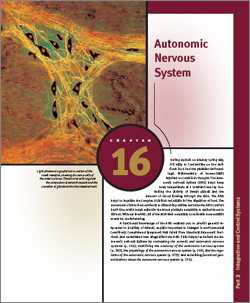
 | During a picnic on a sunny spring day, it's easy to concentrate on the delicious food and the pleasant surroundings. Maintenance of homeostasis requires no conscious thought. The autonomic nervous system (ANS) helps keep body temperature at a constant level by controlling the activity of sweat glands and the amount of blood flowing through the skin. The ANS helps to regulate the complex activities necessary for the digestion of food. The movement of absorbed nutrients to tissues is possible because the ANS controls heart rate, which helps maintain the blood pressure necessary to deliver blood to tissues. Without the ANS, all of the activities necessary to maintain homeostasis would be overwhelming. A functional knowledge of the ANS enables you to predict general responses to a variety of stimuli, explain responses to changes in environmental conditions, comprehend symptoms that result from abnormal autonomic functions, and understand how drugs affect the ANS. This chapter examines the autonomic nervous system by contrasting the somatic and autonomic nervous systems (p. 562); describing the anatomy of the autonomic nervous system (p. 563), the physiology of the autonomic nervous system (p. 569), and the regulation of the autonomic nervous system (p. 573); and examining functional generalizations about the autonomic nervous system (p. 576). |